Campaign
Media bias and abortion
3 year forensic review shows overwhelming pro-abortion bias in the Irish Times - both in news and opinion articles.
#BiasKillsDebate
91% of Irish Times articles showed pro-abortion bias, forensic 3 year analysis finds.
An extensive forensic analysis of every article published by the Irish Times (in the years 2013 - 2015) on abortion has shown overwhelming and persistent bias in favour of abortion, both in the paper’s news reporting and opinion pieces.
Amongst the key findings from the forensic review of the period from January 2013 to December 2015 were:
- Of the 312 articles published by the paper that showed a bias on the issue, 91% were found to have exhibited a pro-abortion bias. (284 of 312 articles)
- For news reporting the bias was most evident, with 98% of news reports which were biased showing a bias in favour of abortion. (205 of 209 articles)
- Almost 77% of opinion pieces for the period showed a bias in favour of abortion with just over 23% taking a pro-life position. (79 against 24 articles)
- The Irish Times published an average of 2 articles per week in favour of abortion (review of 3 years: 2013, 2014 and 2015), making the newspaper more of a campaigner than a news agency.
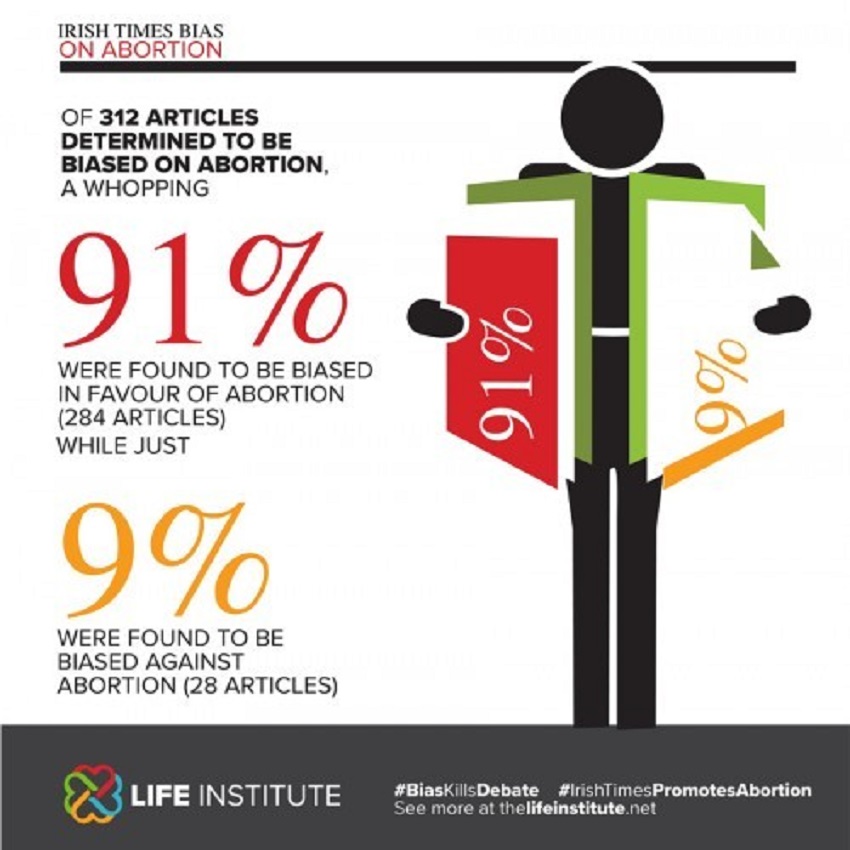
A review of every article published on abortion during a 3 year period.
Every Irish Times article that dealt explicitly and primarily with abortion between January 2013 and December 2015 was examined, an undertaking that saw 766 articles being analysed.
These articles fell into numerous categories including news, opinion, social affairs, health, politics, and the courts - reflecting how the abortion issue touches so many aspects of public and private life.
In order to determine if an article was balanced or biased, we examined each article to see if they contained bias in any of the following 5 categories which are commonly used in assessing media bias.
Only articles that showed bias in two or more of the categories were considered to be a biased article.
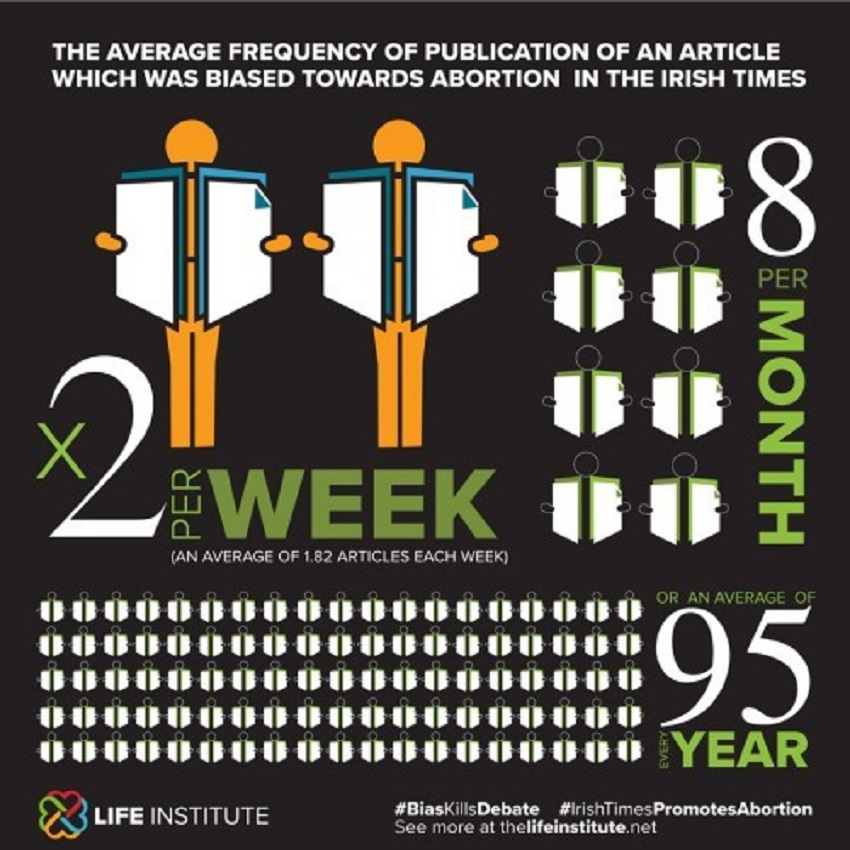
1. Bias through selection and/or omission
- Bias through selection or omission is expressed when the writer either includes or omits certain information in order to convey a certain viewpoint.
- An example of this sort of bias was regularly seen in the reporting in the Savita Halappanavar case wherein a disproportionate amount of coverage was given to the so-called “Catholic comment” made by midwife Anne Marie Burke who was treating Mrs. Halappanavar. Ms Burke confirmed to the Coroner’s Court that the remark was made casually and had no bearing on the medical care of Ms Halappanavar. The Coroner noted that Irish public hospitals do not follow any religious tenets or dogma. However, an article by Kitty Holland, which appeared on the same day as the facts were made known in the Coroner’s Court, repeated the ‘catholic comment’ claim, but again omitted to include the evidence that the comment had no bearing on Ms Halappanavar’s treatment.
- http://www.irishtimes.com/news/health/husband-relieved-truth-about-savita-s-death-emerging-1.1358306

2. Bias through placement
How an article is organized is important to how the reader understands and interprets the story.
- Most news stories are written in the “inverted pyramid” style - with the items the writer considers to be most newsworthy at the top of the article, followed by supporting details, with background information to provide context at the end. The last section provides information that readers are least likely to read and is generally most likely to be cut by editors.
- This bias is most evident when one view makes up almost the entire article with an opposing view only afforded a disproportionately restricted space to offer an alternative view. This can be a form of bias as it is context that frequently allows readers a full understanding of the topic.
- An example of this bias can be seen in a 22 June 2013 article on the death of a woman who travelled from Ireland and underwent an abortion in a Marie Stopes clinic in London. The woman suffered an internal tear as a result of the abortion, and bled to death after being discharged from the clinic.
The Irish Times article downplayed the role of the abortion clinic and the trauma suffered by the woman, choosing instead to use her death to call for abortion to be legalised in Ireland.
The article, entitled “Death shows need for abortion services, family planning organisation says,” quoted abortion supporters at length, including lengthy quotes from the IFPA, National Women’s Council, ROSA and Ruth Coppinger TD. A partial quote from a pro-life spokesperson was included at the very end of the article.
The article ran to some 572 words. Just 48 words were given to a pro-life response. 439 were given to abortion supporters.
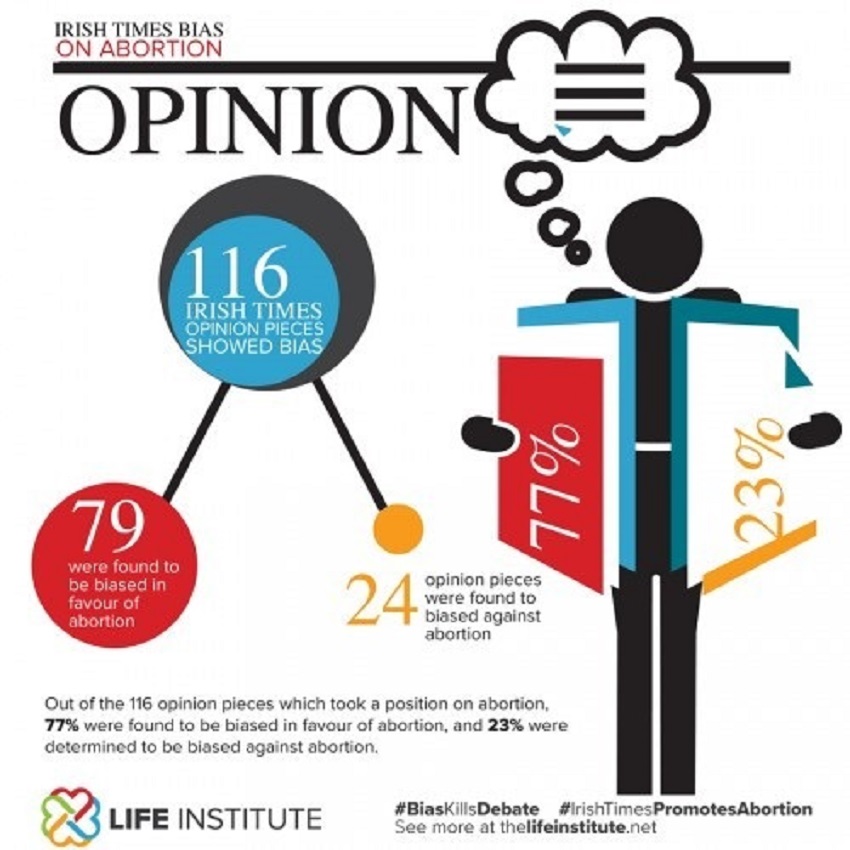
3. Bias through headline
- Headlines can be used to convey bias of the writer or of the editor.
- The headline can either accurately encapsulate the facts of the story or it can be crafted to incite a certain response from readers.
- For example, when a headline reads “Ireland in breach of human rights convention with abortion law” it takes a strong position on an issue. While the article may go on to say that an international committee had formed an opinion regarding Ireland’s abortion policy, a casual reader only takes in the headline which leans clearly to one side of the debate.
- http://www.irishtimes.com/news/social-affairs/ireland-in-breach-of-human-rights-law-on-abortion-1.1867539
4. Bias through tone and/or language
- Bias can be conveyed through the tone or the word choices used. Word connotations can be used to sway the reader towards a particular viewpoint.A prime example of this can be seen in the use of the term “incompatible with life” or “fatal fetal abnomality” which is regularly used in The Irish Times, and in the Irish media in general, but which is not found in the medical literature and is, in fact, offensive to families of children with life-limiting conditions.
- The use of overly emotional language in a news article can also show a certain bias on the part of the author.
- Additionally the use of quotation marks around certain words in order to discredit them could also be seen as bias through tone. This can be seen in the way the Irish Times (who tend to refer to those who oppose abortion as anti-choice) will occasionally use the term “pro-life” in quotation marks.
- The Irish Times, in a February 2014 editorial, admitted that the paper “does not allow the use by our reporters in the context of reporting the abortion debate” the “loaded term ‘pro-life’ as a news description.” However, the term ‘pro-choice’ is frequently used in news descriptions in the Irish Times.
- http://www.irishtimes.com/opinion/the-right-to-be-wrong-1.1680497
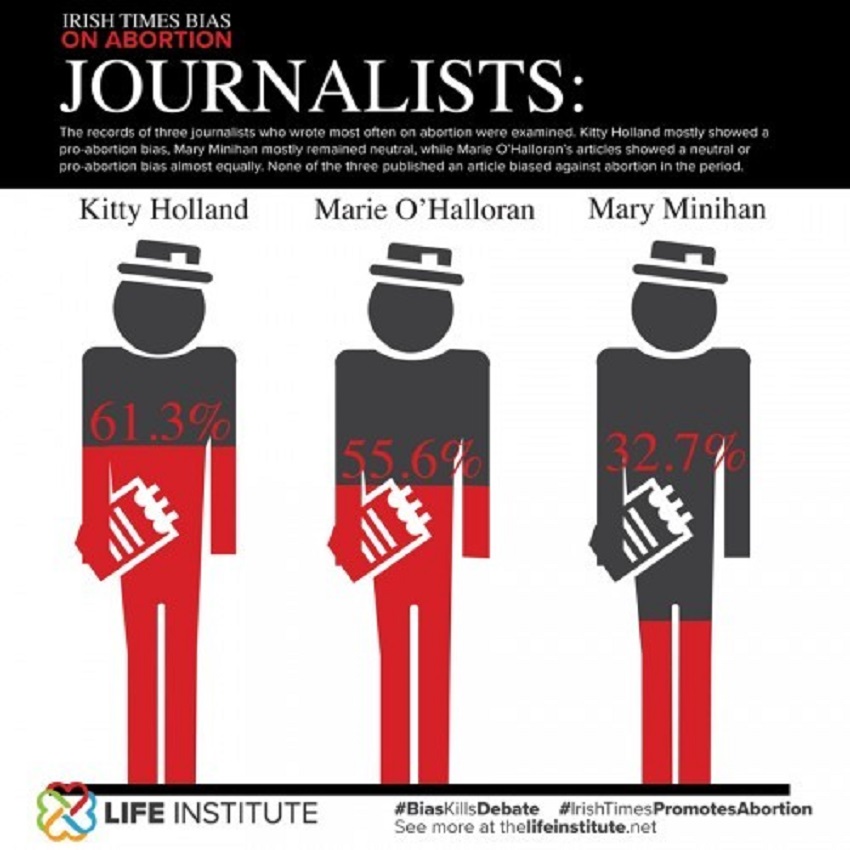
5. Bias through sources
- Bias can be conveyed through the source that the journalist is using. Is the writer using a neutral source? If not, are they using sources or spokespeople from both sides of the issue?
- Additionally, it is important that those speaking on the issue are roughly equivalent to each other. For example, if you are discussing the issue of abortion and you have a member of Doctors for Choice speaking on the need to repeal the 8th amendment, it would be responsible to try and have a pro-life doctor quoted in the same article.
- Another example of bias through source in the area of abortion would be to have someone known publically as an advocate for legal abortion used as a medical source within an article.
This can be seen in the article “Inquest finding will prove challenging for legislators” which uses Dr. Peter Boylan and Dr. Simon Mills (both of whom have publically supported legalising abortion in Ireland) as sources.
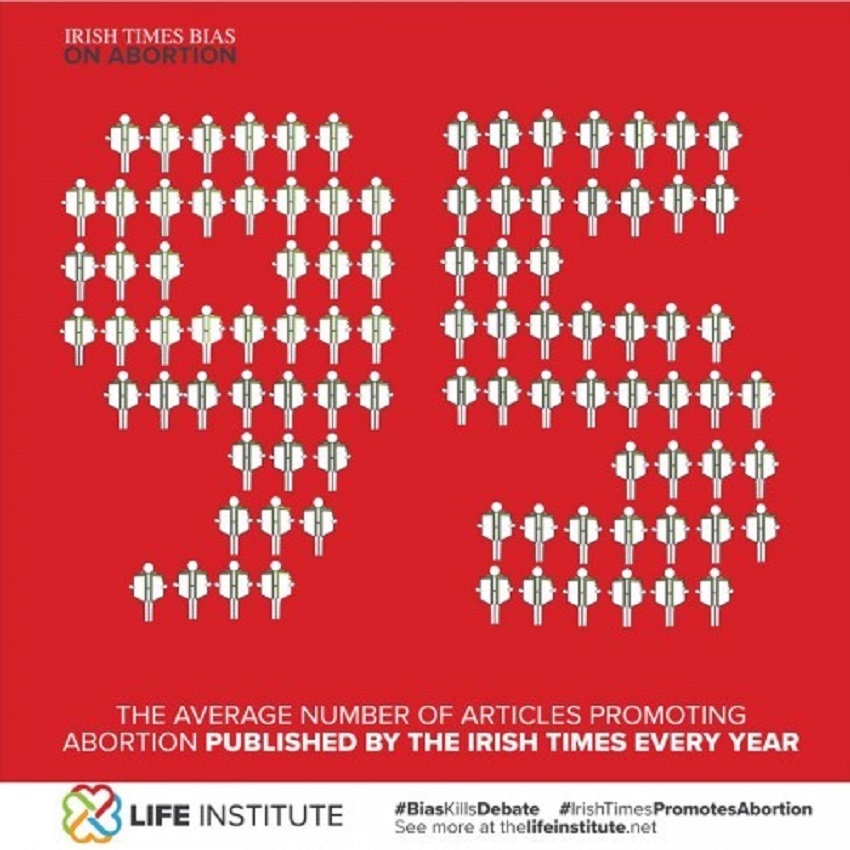
Determining Bias
In order for an article to be considered biased, we decided that the article would have to show bias on at least two of the above criteria.
In total, it was determined that of 766 Irish Times articles on abortion published during 2013-2015, a total of 312 articles showed bias on abortion.
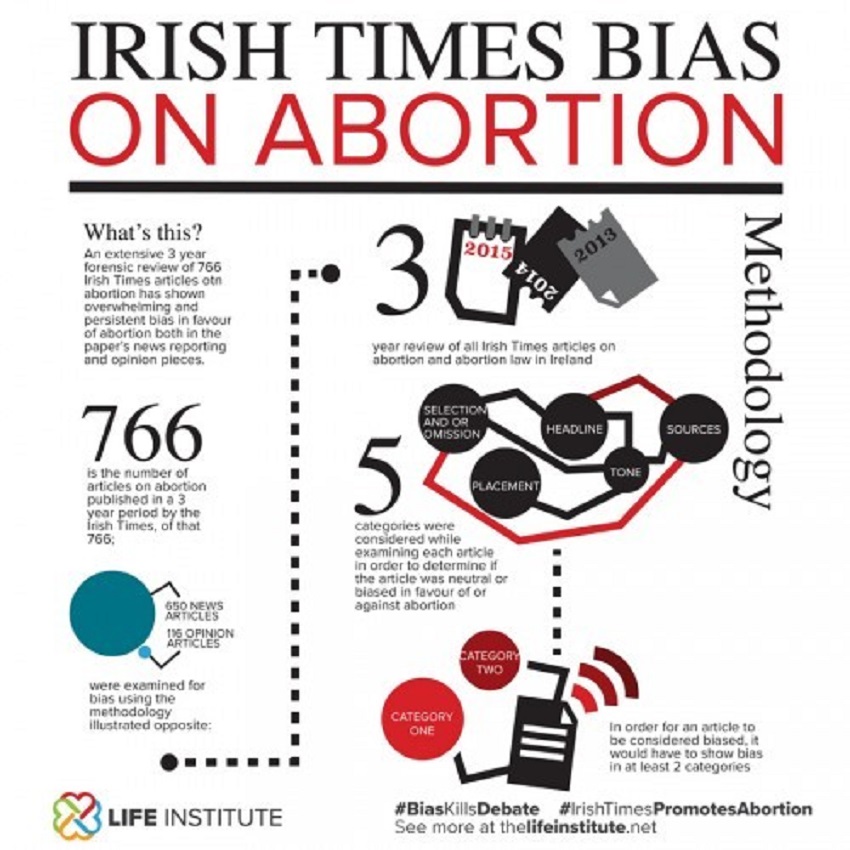
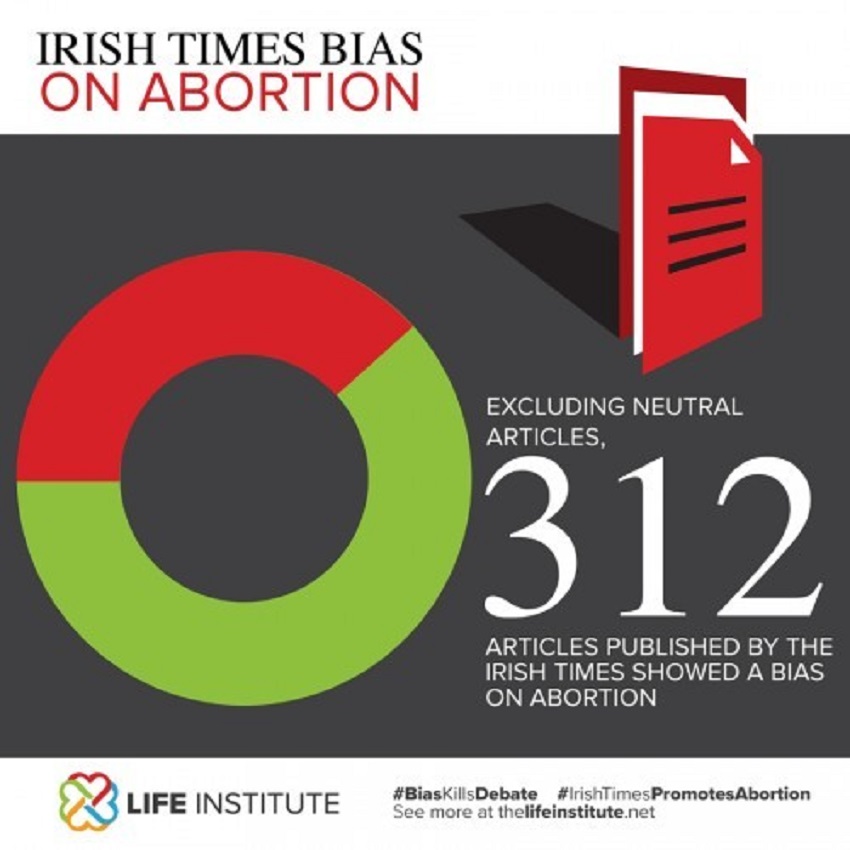
The Results
91% of those articles were biased in favour of abortion. Just 9% of the articles showed a bias against abortion.
The bias was most evident in news reporting with an overwhelming 98% of the biased articles showing a bias in favour of abortion.
On average, the Irish Times published two articles biased in favour of abortion every week. Articles taking a pro-life position appeared less than 10 times a year.
The records of three journalists who wrote most often on abortion were examined. Kitty Holland mostly showed a pro-abortion bias, Mary Minihan mostly remained neutral, while Marie O’Halloran’s articles showed a neutral or pro-abortion bias almost equally. None of the three published an article biased against abortion in the period.
Results per year
In 2013, 215 articles took a stance on the abortion issue or showed a bias one way or the other. 91.6%, or 197 articles, showed a bias towards the pro-abortion position. Only 8.4%, or 18 articles, showed bias against abortion.
2014, saw a significant decrease in the number of articles published regarding abortion. However of the 42 articles that took a stance on the issue, 92.9%, or 39 articles, were found to lean pro-abortion while only 3 articles, or 7.1%, were pro-life.
In 2015, 89.1% (or 49 articles) of the 55 articles were determined to have a pro-abortion bias while 10.9%, or 6 articles, took a pro-life stance.
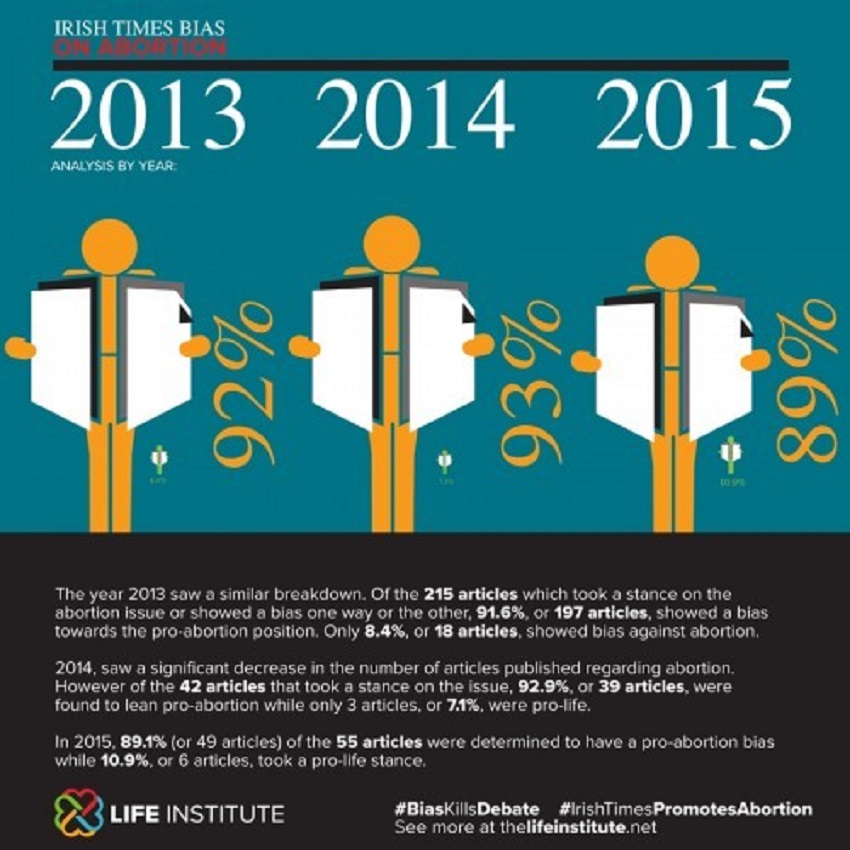
Conclusion
The findings in this review demonstrate clearly that the Irish Times has an overwhelming and persistent bias in favour of legalised abortion.
It is particularly egregious that such overwhelming bias was shown in news reporting, and the results of this analysis can lead to the conclusion that the Irish Times abortion reporting is often opinion disguised as news.
The issue of abortion is both contentious and vitally important in modern day Ireland and it is essential that the Irish people are allowed to engage in an honest and straightforward discussion on the subject, especially as efforts are made to open Ireland’s doors to legalised abortion.
It is the duty of the press to report the news in a fair and balanced manner. Non-biased reporting and greater diversity of opinion are necessary if the people are to engage in a legitimate national discussion on abortion.
Without an end to media bias on this important and sensitive issue, there can be no trust between the people and the press.
Downloads
Video
Link
#BiasKillsDebate
Misleading Claims in the Irish Times
On August 23rd 2013, just a few weeks following the passing of the Irish abortion legislation, an article appeared on the front page of The Irish Times which blazed the headline, “First abortion carried out under new abortion legislation”. The sub-heading read “Case similar to that of Savita Halappanavar” and then went on to describe a case of a woman who was pregnant with twins at 18 weeks and who had developed signs of infection, as did Savita.
However, Irish Times writer Paul Cullen alleged, in contrast to Savita’s case, this woman had undergone a termination of pregnancy at the National Maternity Hospital under the new abortion legislation and her life had been saved. It was suggested that had this legislation been in place at the time of Savita’s death then perhaps her life too would have been saved. The article named Drs Peter Boylan and Rhona O'Mahony, both known abortion campaigners, and said that they had both sanctioned the termination. So far, it seemed like the usual Irish Times abortion advocacy, however, this time their penchant for putting advocacy before journalism would come back to haunt them.
But DOH releases memo to say abortion legislation not enacted yet
On the very same day the article had been printed, the Department of Health released a memo saying that the new abortion legislation had in fact not yet been enacted. So the doctors involved in this story were practicing under the very same laws and guidelines that they had relied on for years, including in October 2012 when Savita Halappanvar was in University Hospital Galway with a septic miscarriage.
No action was taken was taken are the doctors who has supposedly intervened to save the mother's life as pro-abortion advocates had claimed would happen if the abortion law was not changed. In fact, Dr Simon Mills barrister-at-law and former GP said that the procedure was “perfectly legal” irrespective of whether or not the new law had come into place. What the Irish Times tried to re-imagine as an abortion story was, in fact, the most solid proof, if it were ever needed, that Fine Gael's abortion legislation was never needed to save women’s lives. Doctors were always able to intervene in order to save the life of the mother.
The day after the article was printed Dr Peter Boylan went on RTÉ Radio to express his disgust that there had been a confidentiality breach and that the woman involved in this case could potentially be identified. Dr Boylan suggest there was no such case nor did he say anything about the legislation he had supported so vociferously previously. He also made no reference to the fact that Irish Times writer Paul Cullen, who had written the story, specifically mentioned that he, Dr Boylan, had sanctioned the pregnancy to be terminated.
You probably missed the "article" correcting the "mistake"
Ten days later the Irish Times printed a small correction on one of the inside pages saying that “the case described in the article did not happen” and that the article was printed “in good faith”.
The National Maternity Hospital later revealed that in the period from July 30th to August 23rd when the article was printed, two women who had been carrying twins had miscarriages and were treated at the hospital. Neither case bore any resemblance to the case described in The Irish Times leaving the hospital to conclude that no such case even existed. The hospital found that, in all relevant cases under review, the term 'termination of pregnancy' had never been used.
The story seems almost farcical. First we learn that the supposed abortion had not taken place under the new legislation. Then we learned that no such event had ever taken place. The one thing that certain was that the Irish Times was neck deep in something spurious and it was all self-inflicted due to their mindless fixation on promoting abortion.
The media bias in this case is clear, as is the Irish Times' total lack of journalistic integrity when it comes to the life issue. The Irish Times are hell bent on venerating abortion, even if it means carrying a front-page headline that is at worst a complete lie or at best a mistake caused by a blind promotion of abortion.